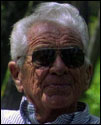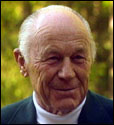|
|
|
|
 |
Men of the X-1
|
|||||||||
|
|
Designing the X-1 Powering | Controlling | Safety | Flying Breaking the Sound Barrier | Reverberations |
|
via RealAudio dialup | broadband Get RealPlayer |
Goodlin: I guess one could say that the X-1 was a
bullet with wings on it. It was a very small aircraft. It was
only 31 feet long and had a 28-foot
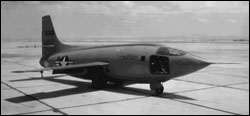 wingspan. However, it was built extremely rugged and it was
possible to withstand enormous forces. The Bell X-1 was really
designed the way it was because the designers at Bell examined
a 50-caliber bullet flying at supersonic speed. And it was a
very stable bullet aerodynamically speaking. And so they
decided to build the X-1 in the form of a bullet with wings.
And that is what the X-1 really turned out to be. It was only
31 feet long, it had a 28-foot wingspan. But the fuselage was
shaped like a bullet.
wingspan. However, it was built extremely rugged and it was
possible to withstand enormous forces. The Bell X-1 was really
designed the way it was because the designers at Bell examined
a 50-caliber bullet flying at supersonic speed. And it was a
very stable bullet aerodynamically speaking. And so they
decided to build the X-1 in the form of a bullet with wings.
And that is what the X-1 really turned out to be. It was only
31 feet long, it had a 28-foot wingspan. But the fuselage was
shaped like a bullet. |
|
via RealAudio dialup | broadband |
Beeler: The fuselage was shaped like a bullet, and the
next thing we saw it had straight wings at about the
mid-section and then the tail was elevated high, and there was
a reason for all of this. The bullet shape was because of
munitions research done many years before. The straight wing,
we advocated that basically because of flight tests we did
with a World War II fighter. The tail was high—we wanted
that to wave in the wake from the turbulence from the wing.
And then I remember one comment said, "Yeah, that looks
great—how about the pilot?" And he didn't have a bubble
canopy anymore. He couldn't see to the rear. And he had this
high slope, aerodynamically it was perfect, but he was stuck
behind that. And the next thing is well, how does he get out?
Well, by this door. And no seat ejection. And then if he
climbs out successfully, and there is a wing right behind him
that could make hamburger out of him, and if that didn't do
it, it would take up and hit in to the tail. So that was kind
of a joking type of a thing. But aerodynamically, particularly
if it was going to be rocket-powered, it looked the most
aerodynamically clean configuration I think that we could come
up with.
Powering the X-1 |
|
via RealAudio dialup | broadband |
Yeager: Basically the X-1 was a pure rocket. It burned
liquid oxygen and a mixture of five parts alcohol to one part
water. You know, we'd been fooling around with jets. Jets
engines didn't have the thrust to push the airplane into the
region of the speed of sound or beyond. |
|
via RealAudio dialup | broadband |
Beeler: Personally I had some reservations about a
rocket, when you see them operate. Because it's like a small
explosion. But it would get you to the area of interest a heck
of a lot quicker and I'm not sure that we knew that much about
a jet engine—the time to get there and all the
aerodynamic problems of getting the air to the engine. The
rocket appeared to be the simplest. |
|
via RealAudio dialup | broadband |
Goodlin: Well, I first operated the rocket engine in a
special test cell at
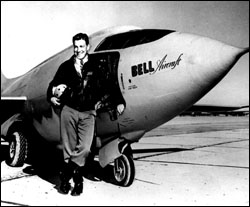 the Bell facility at Niagara Falls. And I must say that it was
a very unnerving experience because the rocket engine made
such an ungodly noise and shook the whole building to its
foundations. And that was the most worrying thing about the
entire X-1 program was the rocket engine. I wasn't worried
about the air frame, but the rocket engine with its volatile
fuels, which were liquid oxygen and ethyl alcohol, gave one
some concern.
the Bell facility at Niagara Falls. And I must say that it was
a very unnerving experience because the rocket engine made
such an ungodly noise and shook the whole building to its
foundations. And that was the most worrying thing about the
entire X-1 program was the rocket engine. I wasn't worried
about the air frame, but the rocket engine with its volatile
fuels, which were liquid oxygen and ethyl alcohol, gave one
some concern.NOVA: What was your concern? Goodlin: That we would have an explosion in the rocket engine. Controlling the X-1 |
|
via RealAudio dialup | broadband |
Beeler: Well, when you reach the—near the speed
of sound, you develop what we call a shock wave. And behind
that shock we call it a dead water region. In other words
anything that tried to operate behind the shock would become
extremely ineffective—almost no effectiveness at all.
And this occurred in some of the fighter airplanes when they
dove at very high speeds from World War II, and we knew it
would happen on the X-1 and it did. But we had a backup in
which we had installed an adjustable tail plane in which we
could use that, you might say, as an emergency device in which
it would give the pilot longitudinal control. And it
worked. |
|
via RealAudio dialup | broadband |
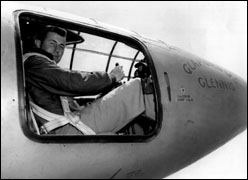 Yeager: When we got the airplane up to 94 percent of
the speed of sound and I'm sitting out there and I decided to
turn the airplane I pulled back on the control cock, nothing
happened, the airplane just went the way it was headed. And I
said, man, we've got a problem. So I raked the rockets off,
and jettisoned the liquid oxygen and alcohol and came down and
landed and we got the engineers together and we had a little
heart to heart talk. I said, "We've got a
problem—because the airplane may pitch up or pitch down.
I've lost the ability to control it."
Yeager: When we got the airplane up to 94 percent of
the speed of sound and I'm sitting out there and I decided to
turn the airplane I pulled back on the control cock, nothing
happened, the airplane just went the way it was headed. And I
said, man, we've got a problem. So I raked the rockets off,
and jettisoned the liquid oxygen and alcohol and came down and
landed and we got the engineers together and we had a little
heart to heart talk. I said, "We've got a
problem—because the airplane may pitch up or pitch down.
I've lost the ability to control it."
Safety and the X-1 |
|
via RealAudio dialup | broadband |
Goodlin: As a matter of fact I was unhappy about the
X-1 from the escape potential because it was very badly
designed from that standpoint. The entrance hatch was on the
side directly in front of a very sharp wing. And I felt that
if one had to bail out of the airplane in an emergency, if one
didn't hit the wing, one would hit the horizontal tail
surface, and therefore I thought it was a very dangerous
airplane. |
|
via RealAudio dialup | broadband |
Yeager: Colonel Boyd, you know, sort of evaluated
everything and ended up calling me in and said, you know, if
you get the X-1 program we... pay attention and fly safe and
don't bust your fanny. And I said, "Yes sir." And that was
about the end of it. And then about a month later, after I'd
been assigned to the X-1 program he called me back in and
said, "You know, we've got a problem." He said, "I wanted a
pilot who had no dependents." I said, "Hey, Colonel Boyd," I
said, "I, yeah, I'm married and I, I've got a little boy, and
I, I think that makes me more careful." And that worked out.
He said, "Well, OK, be careful." |
|
via RealAudio dialup | broadband |
Goodlin: I can't imagine why they got to the point of
building the airplane without having proper escape provisions.
I don't know how that ever happened, but I was not involved in
designing the airplane. NOVA: Isn't that a sign that the, the project is being made more important than the lives of the pilots who are being asked to test it out? Goodlin: Of course. But this happens all the time in the military-industrial complex. NOVA: So did it make you feel almost like a pawn in the game? Goodlin: Well, I think at that stage in my life I wasn't thinking about analyzing the military-industrial complex. Today I do. But at that time I was just a, a very eager adventurer, and I loved flying. And being involved in the hottest aviation project in the world causes one to overlook the basic fundamentals, such as pilot safety. NOVA: What about the dangers in flying this plane? |
|
via RealAudio dialup | broadband |
Yeager: That's immaterial. Duty above all else. See, if
you have no control over the outcome of something, forget it.
I've learned that in combat. You know, you know somebody's
going to get killed, you just hope it isn't you. But you've
got a mission to fly and you fly. And the same way with the
X-1. When I was assigned to the X-1 and, and was flying it I
gave no thought to the outcome of whether the airplane would
blow up or something would happen to me. It wasn't my job to
think about that. It was my job to do the flying.
Flying the X-1 |
|
via RealAudio dialup | broadband |
Goodlin: Well, it was a very exciting experience as you
know. The X-1 was carried aloft in the bomb bay of a B-29. And
the procedure of going down the ladder and crawling into the
X-1 at 8,000 feet and then sealing the door and
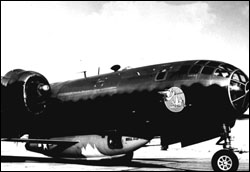 being carried still higher to 28,000 feet, it was rather
exciting, you know. I had no apprehension about it because we
had no rocket fuel on board. And so when we got to altitude
and went through the normal procedure of countdown and here I
was in a very tiny cockpit and it was very dark, and all of a
sudden when the X-1 was released from the B-29 I was in bright
sunlight and I could hear nothing, it was so silent. And it
took my eyes awhile to become accustomed to the daylight. And
of course as one was without any power it was necessary to
immediately examine where our position was in relation to the
airport because one had to always stay within the landing
distance, or gliding distance of the lake bed—and at the
same time put the aircraft through the maneuvers, stall tests
and the stability and control tests. And it was all very
exciting but it went off extremely well. And I landed on the
lake bed without any difficulty.
being carried still higher to 28,000 feet, it was rather
exciting, you know. I had no apprehension about it because we
had no rocket fuel on board. And so when we got to altitude
and went through the normal procedure of countdown and here I
was in a very tiny cockpit and it was very dark, and all of a
sudden when the X-1 was released from the B-29 I was in bright
sunlight and I could hear nothing, it was so silent. And it
took my eyes awhile to become accustomed to the daylight. And
of course as one was without any power it was necessary to
immediately examine where our position was in relation to the
airport because one had to always stay within the landing
distance, or gliding distance of the lake bed—and at the
same time put the aircraft through the maneuvers, stall tests
and the stability and control tests. And it was all very
exciting but it went off extremely well. And I landed on the
lake bed without any difficulty.It was a very delightful airplane to fly, as a matter of fact. It had the, the handling characteristics of a fighter plane. And it was very agile. I had no complaints about the flying qualities of the airplane at all. The serious points on the X-1 were the rocket engine and those escape provisions. |
|
via RealAudio dialup | broadband |
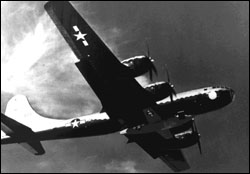 Yeager: Since the airplane was liquid rocket powered it
only had two and a half minutes of power under full thrust.
And consequently we decided to drop it from a B-29 mother-ship
to conserve fuel. And that's the way every flight, with the
exception of one, was launched from a B-29 or a 35... at
around 25,000 feet. After drop, clear of the B-29 you'd fire
off one, two or three or four chambers of the rocket motor.
They were not throttle-able. You could just select the
chambers either on or off, and you ran it until it ran out of
fuel. And then you dead sticked into, into Roger's Dry Lake.
Yeager: Since the airplane was liquid rocket powered it
only had two and a half minutes of power under full thrust.
And consequently we decided to drop it from a B-29 mother-ship
to conserve fuel. And that's the way every flight, with the
exception of one, was launched from a B-29 or a 35... at
around 25,000 feet. After drop, clear of the B-29 you'd fire
off one, two or three or four chambers of the rocket motor.
They were not throttle-able. You could just select the
chambers either on or off, and you ran it until it ran out of
fuel. And then you dead sticked into, into Roger's Dry Lake.
|
|
via RealAudio dialup | broadband |
Goodlin: So then when the drop took place, one would
sort of count to ten and hit the rocket engine control. And we
had four positions on the rocket engine for each rocket
chamber. And to fire up one rocket. And of course the first
time I did it, it was like being hit in the back with a lead
boot. And the aircraft accelerated very, very rapidly. And of
course as one increased the thrust by adding more rocket
positions—actuating more rocket positions—well,
the aircraft could go very fast indeed, and quickly leave
behind the B-29 and the chase plane. And of course the first
time I did that, why shortly after I accelerated, the fire
warning light came on. And that caused the adrenaline to flow.
And so I immediately shut off the rocket motor and called Dick
Frost on the radio, who was flying the chase plane, and asked
him if he could see any fire—that my fire warning light
had come on. And of course he was way behind me and said he
couldn't see any evidence of fire. But after I had slowed
down, why he could pull up behind me and he could still see no
evidence of fire, but my fire warning light was still on. So I
dumped the rest of the fuel and went back to the landing area
and set the airplane down. And sure enough we had sustained a
rather serious fire in the engine compartment. NOVA: When the fire warning light came on, describe your feelings. Goodlin: Well, it's a rather hopeless feeling because one can't see behind from the X-1 cockpit. And so one can only assume the worst, that there's a fire raging there. And so all I could do was wait until Frost could pull up behind and tell me that there was no, absolutely no fire visible. But obviously one thinks all sorts of things, and of course I was concerned because of the lack of escape provisions in the airplane. Breaking the Sound Barrier |
|
via RealAudio dialup | broadband |
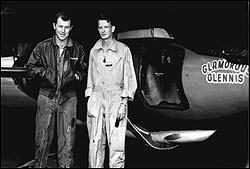 Yeager: The flight, October 14, fell on a Tuesday. And
I think Glennis, my wife and I, were over at Pancho's having
dinner, and we went horseback riding. I ended up breaking a
couple of ribs when the horse hit a fence and tumbled. And
when Monday come along, I got Jack Ridley and said, I've got a
problem, I've got a couple of broken ribs, I can't—I
don't think I can close the door with my right side, my right
arm, and he, that's when he got the broomstick and I stuck it
in with my left arm and closed it. And once we found that out,
as far as getting into the airplane—it was very, oh,
painful, because you have to bend up double to slide in. Once
I got in it was no problem.
Yeager: The flight, October 14, fell on a Tuesday. And
I think Glennis, my wife and I, were over at Pancho's having
dinner, and we went horseback riding. I ended up breaking a
couple of ribs when the horse hit a fence and tumbled. And
when Monday come along, I got Jack Ridley and said, I've got a
problem, I've got a couple of broken ribs, I can't—I
don't think I can close the door with my right side, my right
arm, and he, that's when he got the broomstick and I stuck it
in with my left arm and closed it. And once we found that out,
as far as getting into the airplane—it was very, oh,
painful, because you have to bend up double to slide in. Once
I got in it was no problem. |
|
via RealAudio dialup | broadband |
Yeager: We didn't—we had no idea anything was
going to happen. There was some indication on the previous
Friday's flight that we had a very large error in our Mach
meter. Otherwise we were indicating about 9.3, or .94 Mach
number which was 94 percent of the speed of sound. There's
some indication when NACA reduced the data from our
instrumentation in the airplane that we're going a
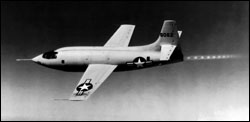 lot faster than indicated. And there was some, a little bit of
excitement that said, hell, we, it looks like we've, we've
been up to about 99 percent of the speed of sound. And we
still are in buffeting and the airplane is shaking quite a
bit. You know, they weren't sure, because you, you're in an
area where very little is known. They had no wind tunnel data,
nothing, and everything was trial and error. And there was
some indication that we had been going faster than we had
thought. But we had no idea what was going to happen on the
next flight. And when we got the airplane up to oh, about 96
percent of the speed of sound indicated, that was almost Mach
1. And when we went a little faster the Mach meter went off
the scale. And ah, when it did all the buffeting smoothed out,
because of the supersonic flow of the whole airplane. And even
I knew we had gotten above the speed of sound. And I let it
accelerate on out to about 1.06 or 1.07, seven percent above
the speed of sound, and the airplane flew quite well. And I
got some elevator effectiveness back, but not very much.
lot faster than indicated. And there was some, a little bit of
excitement that said, hell, we, it looks like we've, we've
been up to about 99 percent of the speed of sound. And we
still are in buffeting and the airplane is shaking quite a
bit. You know, they weren't sure, because you, you're in an
area where very little is known. They had no wind tunnel data,
nothing, and everything was trial and error. And there was
some indication that we had been going faster than we had
thought. But we had no idea what was going to happen on the
next flight. And when we got the airplane up to oh, about 96
percent of the speed of sound indicated, that was almost Mach
1. And when we went a little faster the Mach meter went off
the scale. And ah, when it did all the buffeting smoothed out,
because of the supersonic flow of the whole airplane. And even
I knew we had gotten above the speed of sound. And I let it
accelerate on out to about 1.06 or 1.07, seven percent above
the speed of sound, and the airplane flew quite well. And I
got some elevator effectiveness back, but not very much. |
|
via RealAudio dialup | broadband |
Beeler: And then, The best I remember now, we knew the
rocket was on, and we really didn't get anything back from
Chuck. You'd have to look at the telemeter data if we did. But
as far as us listening, the next thing is that Chuck says, I
think he did make a remark on his longitudinal control, I
forgot. But the next thing my Mach meter jumped. And then at
that time we got a bang. And personally, I have to say, I
didn't know anything about bangs. I didn't know anything about
it. Someone may say they knew about it from gunshots and that
sort of thing, but to people around there, we got a bang. |
|
via RealAudio dialup | broadband |
Yeager: Your emotions on something like
that—you're too busy staying on top of the dome
regulators and watching the chamber pressures and doing
everything you're supposed to. And you might say I was a
little bit disappointed it didn't blow up. That's about the
only way to say—hell, it's a piece of cake.
Reverberations |
|
via RealAudio dialup | broadband |
Yeager: A lot of the news media were digging, you know,
and I'm sure the intelligence people from the Soviet Union and
the French and the British were all digging. Then after about
seven months, you know, we satisfied their digging. We
released the fact that we had flown faster than the speed of
sound. That, you know, that satisfied their digging. What they
didn't know was how we had done it. |
|
via RealAudio dialup | broadband |
Beeler: When Chuck made that supersonic flight it
opened up a big wide door and everybody could jump in with all
these applications. And that was one—that probably is
the biggest impact as far as the world economy—people in
one world type of thing. |
|
via RealAudio dialup | broadband |
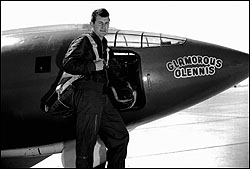 Yeager: Obviously the reason we kept it classified was
to keep the rest of the world from finding out about a flying
tail that's necessary to control the airplane through the
speed of sound. It resulted in a kill ratio of 10 to 1 between
the F-86 and the MiG 15. That one simple thing, of putting a
flying tail on the F-86, because we knew that it would dive to
the region of the speed of sound, and it pitted it against the
MiG 15 in Korea, in 1951, '52, and '53, and we had a kill
ratio of 10 to one. And when I flew the MiG 15 over there for
the first time I was amazed, because it was a good airplane,
just like the Hawker-Hunter was or the MD-452, that Dassault
built for the French air force, but it didn't have a flying
tail on it.
Yeager: Obviously the reason we kept it classified was
to keep the rest of the world from finding out about a flying
tail that's necessary to control the airplane through the
speed of sound. It resulted in a kill ratio of 10 to 1 between
the F-86 and the MiG 15. That one simple thing, of putting a
flying tail on the F-86, because we knew that it would dive to
the region of the speed of sound, and it pitted it against the
MiG 15 in Korea, in 1951, '52, and '53, and we had a kill
ratio of 10 to one. And when I flew the MiG 15 over there for
the first time I was amazed, because it was a good airplane,
just like the Hawker-Hunter was or the MD-452, that Dassault
built for the French air force, but it didn't have a flying
tail on it.Photos: (1,3) NOVA/WGBH Educational Foundation; (2) Aila Vainio; (4,6-11) AFFTC; (5) Chalmers H. "Slick" Goodlin. Men of the X-1 | Secret History | Sonic Boom | Speed Machines Resources | Teacher's Guide | Transcript | Faster Home Editor's Picks | Previous Sites | Join Us/E-mail | TV/Web Schedule About NOVA | Teachers | Site Map | Shop | Jobs | Search | To print PBS Online | NOVA Online | WGBH © | Updated October 2000 |
